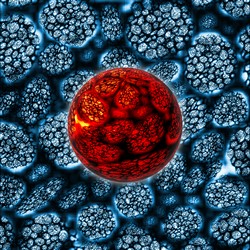Novel drug delivery vehicles
The modern pharmaceutical industry faces a great challenge with lipophilic therapeutic molecules. Nearly 40 % of these drugs are rejected because of their poor water solubility and stability. As a result, there is great demand for the development of novel carrier vehicles for hydrophobic drugs. Existing solutions comprise emulsions, liposomes, micelles and nanoparticles but these suffer from certain disadvantages, including the fast and non-specific clearance from the circulation and a limited drug loading capacity. Ideally, drug delivery vehicles should be thermodynamically stable, be capable of moving through blood capillaries, have high drug loading capacity and exhibit controlled drug release. To address this, scientists on the EU-funded RTILS-GELS (Novel delivery platform for hydrophobic drugs) project proposed to develop nanogels with affinity for both water and organic liquids. For this purpose, they employed 20 different biocompatible room temperature ionic liquids based on 1-vinylimidazole (VMIM) and amino acids, as well as nanoparticulate co-polymeric gels with 1-vinyl-2-pyrrolidone (NVP) and 2-hydroxyethyl methacrylate (HEMA). Results indicated a superiority of HEMA over NVP in its polymerisation capacity to give gels with 16 of the tested ionic liquids. By using Ibuprofen as a model drug, researchers demonstrated an efficient uploading capacity using ethanol as the solvent. Nanoparticulate gels were extensively characterised in terms of size, surface charge and biocompatibility, and exhibited low cytotoxicity in vitro. Collectively, the activities of this project illustrated the possibility of generating copolymeric nanogels based on ionic liquids with dual affinity for both water and organic solvents. Although the copolymers of VMIM and amino acids proved better carriers in organic liquids, further exploration of the RTILS-GELS synthetic approach should lead to improved vehicles for the delivery of hydrophobic drugs.







